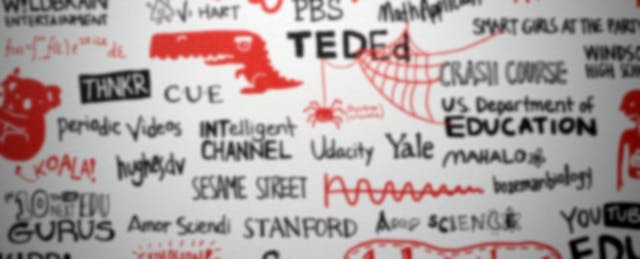The YouTube Education Summit marked the first gathering of educators and content producers interested in expanding YouTube's EDU portal. Veterans of video teaching like Steve Spangler and Sal Khan were present, as well as representatives from public broadcasting like Sesame Street Workshop, KQED, and WGBH. But the rockstars of the event were its gurus--content producers like Michael Stevens (Vsauce), who gained over a million subscribers by answering questions like "What color is a mirror?" and Henry Reich, whose Minute Physics series tells us what would happen if the Earth were hollow. Also present were winners of the YouTube Next Guru competition--up and coming producers like Loretta Scott (KemushiChan) who teaches Japanese language and culture on her YouTube channel and James Earle (AmorSciendi), who mixes art history with math and science.
YouTube EDU has expanded greatly since its inception in 2009. The portal currently consists of 1000 channels. Each is manually checked by Computer Using Educators for educational value and content--a strategy that won't scale on a site that adds 11 years worth of content to its servers every day.
Much of the summit's conversation focused on the current problem YouTube faces with the snacking mentality of its users. They are sent individual links by friends and websites or search for videos they need, but they don't stay around for long. Exploration is further stilted by the website's recommendation system. It is difficult to support surfing algorithmically as the reasons behind seeing an initial video are so varied--there is no guarantee that someone watching a genuine Sesame Street video will want to see an Elmo parody afterwards. (Tread carefully, preschool teachers!) YouTube's recent emphasis on channels marks its strategic shift from view counts to total watch time. It's easy to see why it selected these creative gurus to shake users out of their snacking habits.
The most colorful panel at the summit revolved around monetization. Most independent content creators admitted to being supported by ad revenue and about half of those said they did so out of necessity. While Google does not disclose what it pays its AdSense partners, forums estimate that partners make between $0.001 and $0.005 a click depending on what type of ads they run. And here's where YouTube EDU stumbles: partners that opt into the EDU program do not get a separate account for their EDU channel. This means that ads will run on their channel even if it's accessed through YouTube EDU. School system admins have to change network settings with YouTube for schools to disable ads and comments. And partners can only deselect a limited number of ad types. One teacher reported that her class sat through a tequila ad because she played a video about Cinco de Mayo. To which Jonathan Schorr of NewSchools remarked, "If my kid is forced to watch a Doritos commercial while at school, I swear I will sue that district."
Richard Culatta of the Department of Education spoke about the importance of aligning content with standards and the actual needs of teachers. Yet it's difficult to imagine producers like Victoria Hart (Vihart) fitting into the mold of Common Core. Hart's rapid editing and stream of consciousness dialogue is meant to be slightly incomprehensible and adds to the magic of the topic at hand. When Khan Academy hired Hart last year, she and Sal Khan initially produced a few videos together. However, it was a stylistic mismatch and, while they still work together, they have since decided to keep their content separate.
Sir Ken Robinson was slated to open the last day of the conference. There was a noticeable buzz for the man who held the title of most watched TED Talk for years. Our moderator announced, "Sir Ken is feeling under the weather and will be joining us online." A palpable silence followed this news. Even for a group of people that had made careers out of video, the aura of physical reality still held value. But before a word of dissent could be spoken the projectors flicked to life, Robinson's smiling face filled the void, and the room carried on as if nothing happened. For these new teacher-stars and their fan-students, video is the new reality.


